英语作文-Asking the Way问路
指路的英语作文4篇
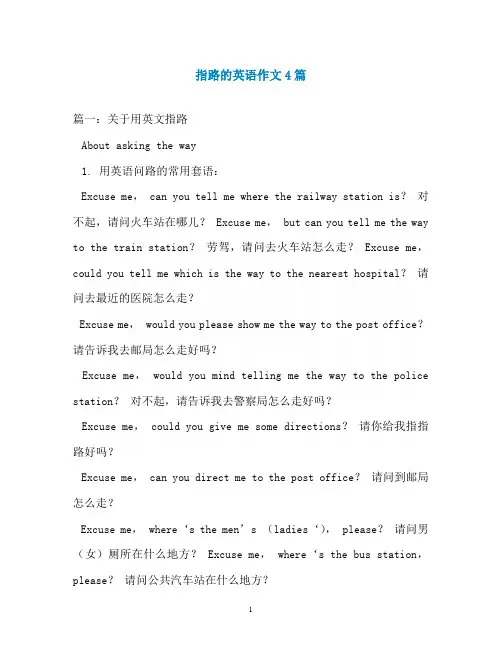
指路的英语作文4篇篇一:关于用英文指路About asking the way1. 用英语问路的常用套语:Excuse me, can you tell me where the railway station is?对不起,请问火车站在哪儿? Excuse me, but can you tell me the way to the train station?劳驾,请问去火车站怎么走? Excuse me,could you tell me which is the way to the nearest hospital?请问去最近的医院怎么走?Excuse me, would you please show me the way to the post office?请告诉我去邮局怎么走好吗?Excuse me, would you mind telling me the way to the police station?对不起,请告诉我去警察局怎么走好吗?Excuse me, could you give me some directions?请你给我指指路好吗?Excuse me, can you direct me to the post office?请问到邮局怎么走?Excuse me, where‘s the men’s (ladies‘), please?请问男(女)厕所在什么地方? Excuse me, where‘s the bus station,please?请问公共汽车站在什么地方?Excuse me, how can I get to the No. 1 Middle School?请问去一中怎么走?Excuse me, could you tell me where there is a public telephone?请问哪儿有公用电话? Excuse me, is this the right way to the People‘s Park?请问去人民公园走这条路对吗? Excuse me, does this bus go to the train station?请问这公共汽车是开火车站的吗? Excuse me, I wonder if you could do me a favour. I‘m looking for the police station?对不起,不知能否帮我,我在找警察局。
6问路asking the way英文对话
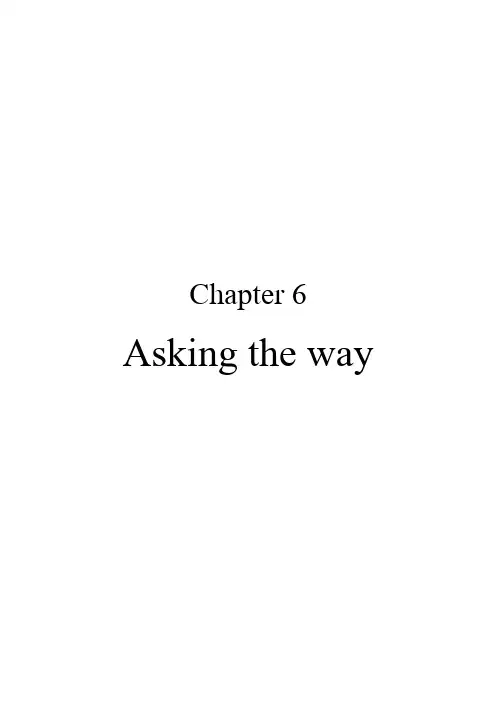
Chapter 6 Asking the way你(A)新到一个城市,向一个过路人(B)打听邮局在哪儿:A:Excuse me, could you tell me where the nearest post office is?对不起,请问最近的邮局在什么地方?B:Yes, it’s that way, about two blocks from here.走那条路,过两条马路就到了。
A:On the right or left side of the street?在马路的左边还是右边?B:On the left. 在左边。
A:Thank you very much. 太感谢你了。
B:You’re welcome. 不客气。
B你(A)新到某市,不知道火车站在哪儿,向某人(B)打听:A:Excuse me, but can you tell me the way to the railway station?请问去火车站怎么走?B:Just go straight along this street, turn left at the first crossing and walk straight ahea d about 100 meters. You can’t miss it.沿着这条街一直往前走,到第一个十字路口向左拐,然后再往前走100米,你就到了火车站。
A:About how long will it take me to get there?去那儿大约要多少时间?B:It’s about 10 minutes’ walk, I think. 步行大概要十分钟。
A:I see. Is there a bus I can take? 我明白了,可以乘公共汽车去吗?B:Yes, you can take the No. 5 bus over there. Get off at the next stop.可以,你可以在那儿乘五路车,在下一站下车。
AskingtheWay问路
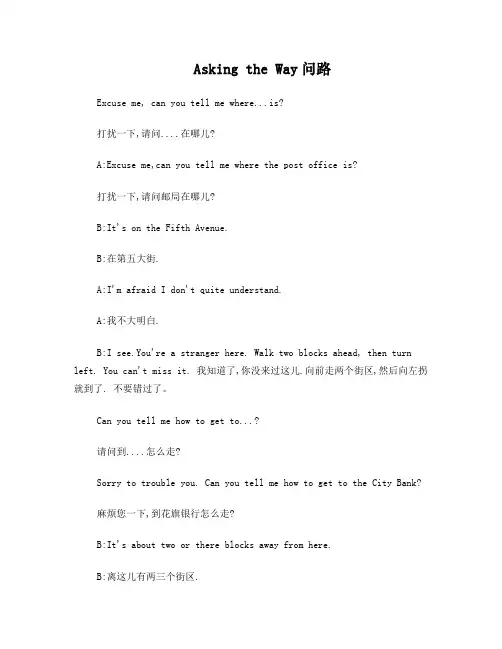
Asking the Way问路Excuse me, can you tell me where...is?打扰一下,请问....在哪儿?A:Excuse me,can you tell me where the post office is?打扰一下,请问邮局在哪儿?B:It's on the Fifth Avenue.B:在第五大街.A:I'm afraid I don't quite understand.A:我不大明白.B:I see.You're a stranger here. Walk two blocks ahead, then turn left. You can't miss it. 我知道了,你没来过这儿.向前走两个街区,然后向左拐就到了. 不要错过了。
Can you tell me how to get to...?请问到....怎么走?Sorry to trouble you. Can you tell me how to get to the City Bank?麻烦您一下,到花旗银行怎么走?B:It's about two or there blocks away from here.B:离这儿有两三个街区.A:How long will it take if I walk?A:走着去需要多长时间?B:It'll take you about 15 minutes.B:大约15分钟.Is there a...near here?附近有....吗?A:Is there a bookstore near here?A:附近有书店吗?B:Yes,it's straight ahead around the comer. B:有,就在前面的拐角处.A:Thank you very much.A:谢谢.Can you direct me to...?您指给我去....路,好吗?A:Can you direct me to Holiday inn?A:请问到最近的医院怎么走?Walk straihgt on. Cross the street and walk two blocks west.You can't miss it.一直往前走,在第二个交通灯那儿过马路就到了.A:Thanks.A:谢谢.Can you show me the way to...?请问去.....该怎么走?A:Can you show me the way to the nearest hospital?A:请问到最近的医院怎么走?Walk straight on.Cross the street at the second traffic light.You can't miss it.一直往前走,在第二个交通灯那儿马路就到了.A:Thank you. B:You're welcome.A:谢谢.B:不用谢.Is this the road to...?这是去.....的路吗?A:Is this the road to Friendship Store?A:这是去友谊商店的路吗?B:You could get there this way, but it's nearer to go along Walt Street. 从这儿走可以到,但从沃尔特大街走更近.A:Where is Walt Street?A:沃尔特大街在哪儿?B:Next to this one.B:下条街就是.Does this bus go to ....?这车开往.....吗?A:How can I get to the zoo?A:我怎样才能到动物园呢?B:You can take a bus.B:您可以坐共汽车.A:Does this bus go to the zoo?B:Yes,it does.这辆车开往动物园吗?B:是的.Which bus should I take if I want to go to ....?去....应该坐哪路车?A:Excuse me, which bus should I take to go to Wood Cinema?打扰一下,去伍德影院应该坐哪路车?B:You can take Bus No.11. It's very convenient.B:您可以坐11路.很方便.A:Thank you.A:谢谢.Can you tell me how I can get to...?怎样才能到......A:Can you tell me how I can get to the Grand Cinema?A:怎样才能到宏大影院呢?It's on the Park Avenue. It's too far to walk. You'd better take a bus. 在帕克大街.步行去太远了.最好坐公共汽车.A:Which bus shall I take? B:Bus No.2.A:坐哪路公共汽车?B:二路.How far it from here to...?这儿离.....有多远?A:How far is it from here to the airport?A:这儿离机场多远?B:About 40 minuters' ride by car.A:Thank you.B:开车四十分钟.A:谢谢.Is there a direct train from...to...?从.....到.....有直达列车吗?A:Is there a direct train from New York to Washington?从纽约到华盛顿有直达列车吗?B:Yes,there is.B:有.A:When does it leave? B:9:20 a.m.A:几点开?B:上午9:20.How long does it take to go from...to...by train?从.....到.....乘火车多长时间?A:How long does it take to go from New York to Washington by train? A:从纽约到华盛顿乘火车多长时间?B:Sorry,I don't know.B:对不起,我不知道.A:That's all right. I can ask the conductor.A:没关系,我可以问乘务员.Is there a direct flight from...to...?从.....到.....有直航班机吗?A:Is there a direct flight from Frankfurt to Tokyo? A:从法兰克福到东京有直航班机吗?B:Yes, there is. It leaves on Thursdays.A:Thank you.。
问路英语作文范文5篇
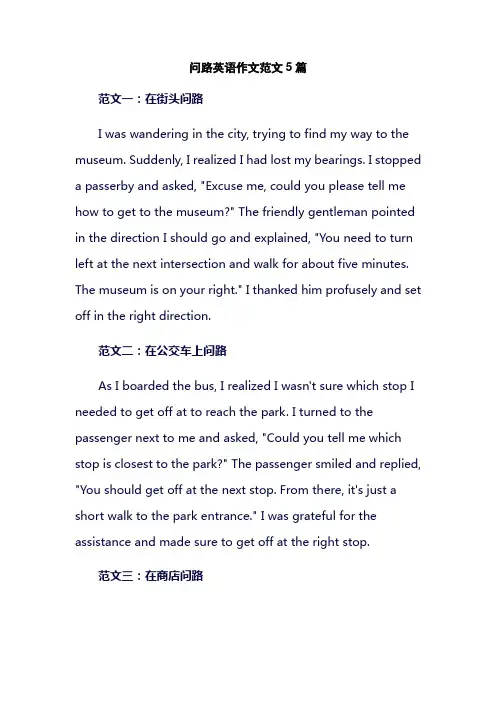
问路英语作文范文5篇范文一:在街头问路I was wandering in the city, trying to find my way to the museum. Suddenly, I realized I had lost my bearings. I stopped a passerby and asked, "Excuse me, could you please tell me how to get to the museum?" The friendly gentleman pointed in the direction I should go and explained, "You need to turn left at the next intersection and walk for about five minutes. The museum is on your right." I thanked him profusely and set off in the right direction.范文二:在公交车上问路As I boarded the bus, I realized I wasn't sure which stop I needed to get off at to reach the park. I turned to the passenger next to me and asked, "Could you tell me which stop is closest to the park?" The passenger smiled and replied, "You should get off at the next stop. From there, it's just a short walk to the park entrance." I was grateful for the assistance and made sure to get off at the right stop.范文三:在商店问路While shopping in a busy mall, I realized I had forgotten the way back to the entrance. I approached a shop assistant and inquired, "Hello, I'm a bit lost. Could you direct me to the mall entrance?" The assistant nodded and pointed to a nearby corridor, saying, "Just follow this corridor, take the first right, and you'll see the entrance straight ahead." I thanked the assistant and made my way back to the entrance with ease.范文四:在旅游景点问路Visiting a new city, I was eager to visit the famous cathedral. However, I soon found myself wandering aimlessly through the city streets. I stopped a tourist and asked, "Please, could you help me find the cathedral? I'm having a bit of trouble navigating." The tourist pointed to a nearby landmark and explained, "You need to head towards that tower, then take a left at the square. The cathedral is just beyond that." With renewed confidence, I set out to find the cathedral.范文五:使用地图应用问路In the age of technology, I often rely on my smartphone to navigate unfamiliar places. Once, while exploring a new neighborhood, I needed to find a specific restaurant. Instead of asking for directions, I opened my map app and searchedfor the restaurant. The app promptly provided me with a detailed route, including turn-by-turn directions. I followed the instructions on my screen and arrived at the restaurant without any hassle.。
关于问路指路的英语作文范文
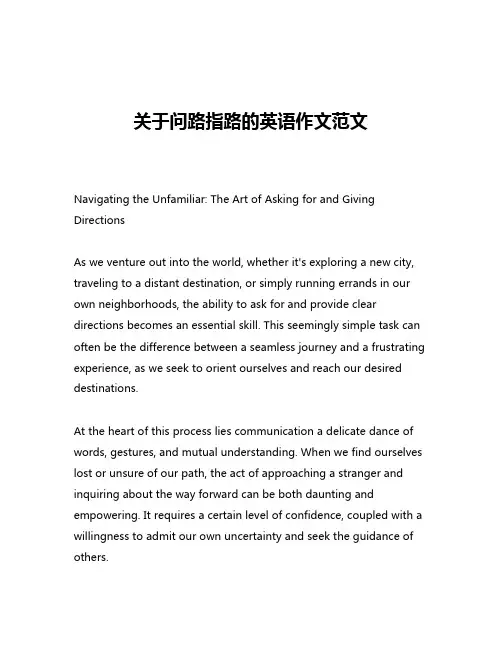
关于问路指路的英语作文范文Navigating the Unfamiliar: The Art of Asking for and Giving DirectionsAs we venture out into the world, whether it's exploring a new city, traveling to a distant destination, or simply running errands in our own neighborhoods, the ability to ask for and provide clear directions becomes an essential skill. This seemingly simple task can often be the difference between a seamless journey and a frustrating experience, as we seek to orient ourselves and reach our desired destinations.At the heart of this process lies communication a delicate dance of words, gestures, and mutual understanding. When we find ourselves lost or unsure of our path, the act of approaching a stranger and inquiring about the way forward can be both daunting and empowering. It requires a certain level of confidence, coupled with a willingness to admit our own uncertainty and seek the guidance of others.One of the key elements in successfully asking for directions is to be specific and concise in our queries. Rather than vaguely asking "How do I get to the city center?" it is far more effective to provide clear landmarks, street names, or even the specific address of our intended destination. This level of detail not only demonstrates our own understanding of where we need to go but also helps the person we are addressing to formulate a more tailored and useful response.Additionally, it is important to be mindful of our body language and tone when engaging in this exchange. A friendly and approachable demeanor can go a long way in putting the other person at ease and encouraging them to provide helpful information. Maintaining eye contact, using polite language, and expressing gratitude for the assistance can all contribute to a positive interaction.Of course, the art of giving directions is equally crucial in this process. The person on the receiving end of our inquiry is entrusted with the responsibility of guiding us to our destination, and their ability to do so effectively can make all the difference. The most skilled direction-givers are those who are able to provide clear, concise, and easy-to-follow instructions, using landmarks, turns, and distances to paint a vivid mental map for the listener.One effective technique in giving directions is to break down thejourney into manageable steps, addressing each turn or landmark in a sequential manner. This not only helps to minimize confusion but also allows the person asking for directions to mentally process the information and visualize the path ahead. Additionally, the use of visual aids, such as hand gestures or even sketched maps, can further enhance the clarity and understanding of the directions being provided.It is also important to be mindful of the specific needs and preferences of the person seeking directions. For example, some individuals may prefer more detailed, step-by-step instructions, while others may respond better to a broader, more holistic overview of the route. Adapting our communication style to the individual can greatly improve the effectiveness of the exchange.Furthermore, the ability to provide alternative routes or suggestions can be invaluable, particularly in cases where the primary path may be obstructed or otherwise unsuitable. By offering multiple options, we demonstrate a deeper understanding of the local geography and a willingness to ensure the person reaches their destination with minimal difficulty.In today's increasingly interconnected world, the need for effective communication and navigation skills has become more important than ever. As we navigate the complexities of modern life, the abilityto ask for and provide clear directions can open up new opportunities, facilitate meaningful connections, and even enhance our sense of personal independence and confidence.Whether we find ourselves in a bustling city, a rural countryside, or even a foreign land, the art of asking for and giving directions remains a vital tool in our arsenal. It is a skill that transcends language barriers, cultural differences, and individual experiences, connecting us to the world around us and empowering us to explore, discover, and thrive.In conclusion, the process of asking for and providing directions is a nuanced and multifaceted endeavor, one that requires a combination of communication skills, spatial awareness, and a willingness to engage with others. By embracing this art, we not only navigate the physical landscape but also cultivate a deeper understanding of the human experience, one step at a time.。
2019年小学英语作文-如何问路-Asking the way
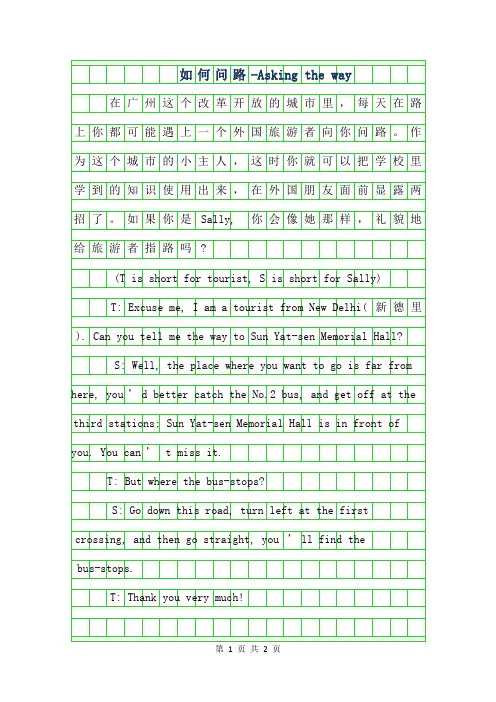
在 广 州 这 个 改 革 开 放 的 城 市 里 , 每 天 在 路 上 你 都 可 能 遇 上 一 个 外 国 旅 游 者 向 你 问 路 。 作 为 这 个 城 市 的 小 主 人 , 这 时 你 就 可 以 把 学 校 里 学 到 的 知 识 使 用 出 来 , 在 外 国 朋 友 面 前 显 露 两 招 了 。 如 果 你 是 Sally, 给 旅 游 者 指 路 吗 ? (T is short for tourist, S is short for Sally) T: Excuse me, I am a tourist from New Delhi( 新 德 里 ). Can you tell me the way to Sun Yat-sen Memorial Hall? S: Well, the place where you want to go is far from here, you ’ d better catch the No.2 bus, and get off at the third stations; Sun Yat-sen Memorial Hall is in front of you. You can ’ t miss it. T: But where the bus-stops? S: Go down this road, turn left at the first crossing, and then go straight, you ’ ll find the bus-stops. T: Thank you very much! 你 会 像 她 那 样 , 礼 貌 地
第 1 页 共 Байду номын сангаас 页
第 2 页 共 2 页
asking-about-the-way问路 英语
In front of the shopping centre.
Behind the taxi rank.
Next to the car park.
Excuse me, can you tell me the way to………?
First on the right.
It’s the second street on the left.
Go down the street. / Go up the street.
10 minutes by car/on foot.
5 minutes walk.
It’s no distance at all.
That’s the biggest/smallest building on the left.
You’ll seБайду номын сангаас post office in front of you.
You can’t miss it.
Where is the entrance?
Is it far from here?
Just a few minutes on foot.
Excuse me. How can I get to……..?
I’m sorry, I don’t know.
I’m a stranger here myself.
Thank you anyway.
Go through the ……….into ……….Street.
Turn left past the Town Hall.
Excuse me. Where is the bus stop?
英语作文问路60个单词
英语作文问路60个单词在英语作文中描述问路是一项常见的任务。
当你在外地旅行或者迷路时,向陌生人问路是解决问题的关键。
以下是一个大致800字的范文,展示了如何用英语描述问路的情景:---。
As a traveler in a foreign land, finding your way around can sometimes be a daunting task. However, askingfor directions is a skill that can help navigate unfamiliar terrain. Here's a typical scenario:Imagine you're strolling down a bustling street in a vibrant city. Suddenly, you realize you've lost your way. You spot a friendly-looking passerby and decide to approach them for help. With a polite smile, you initiate the conversation:"Excuse me, could you please help me find my way to the nearest subway station?"The passerby, sensing your predicament, responds kindly:"Of course! You're currently on Maple Street. The nearest subway station is just a few blocks away. Let me guide you."Grateful for their assistance, you follow their directions:"Thank you so much! Could you please tell me which wayto go from here?"They point you in the right direction:"Sure, you'll want to head straight down Maple Streetfor two blocks, then make a left onto Oak Avenue. You'llfind the subway station on your right-hand side."Appreciative of their guidance, you express your gratitude:"Thank you for being so helpful! I really appreciate it."The passerby smiles warmly:"No problem at all! Enjoy your day and safe travels."With renewed confidence, you set off on your way, following the directions provided. Soon enough, you spot the familiar signs of the subway station and breathe a sigh of relief. Thanks to the kindness of a stranger and the power of asking for directions, you've successfully navigated your way through the city.In conclusion, asking for directions in English is a valuable skill for any traveler. By approaching strangers with politeness and clarity, you can easily find your way even in unfamiliar surroundings. So next time you're lost, don't hesitate to ask for help – you never know how far a simple question can take you.--。
日常情景英语对话范文:问路
日常情景英语对话范文:问路情景对话是英语教学中常见的一个话题,特别对于中小学生的英语学习,这类的情景对话经常出现在考试中,用来考查学生的情景交际能力,和掌握的日常交际用语。
比如问候;打电话、感谢和应答;道歉和应答;邀请和约会;提供帮助;谈论天气;购物;问路等情景在英语教学大纲中经常出现,那么今天就和大家分享一些关于问路的英语情景对话。
日常情景英语对话范文:问路A: Excuse me, Where am I on this map? 对不起,请问我在地图上的什么地方?B: We are here, bus station, we are in the heart of the city. 我们在这里,汽车站,我们现在在市中心。
A: Oh ! I think I’m lost. Can I go from here to the railway station? 哦!我想我迷路了。
我能否从这里到火车站呢?B: Head straight up the street about two blocks then turn left. 顺这条街一直走过两个街区,然后左转。
A: Excuse me. I’m afraid I got lost. Can you show me the way to the station? 对不起,我迷路了,请问您能告诉我去车站怎么走吗?B: I’m walking that way. Let me lead you the way. 我正朝那边去。
让我给你带路吧!A: Excuse me. I wonder if you co uld help me. I’m looking for the Museum. 对不起,打扰一下,不知您能否帮助我,我在找博物馆。
B: Boy, you are lost. It’s across town. 哇,你是迷路了。
它在城的那头。
A: Oh ! What bad luck ! How can I get to the Museum? 哦!太糟糕了!那我怎么去博物馆呢?B: You can take a No. 24 bus here and then transfer to a No.53 bus to get there. 您可以在此乘坐24路公共汽车换乘83路公共汽车到那里。
6问路askingtheway英文对话
(你好,你能告知我去博物馆的路怎么走吗?)
Policeman: Certainly. Just go up this street and turn left at the second crossing1. The third building from the corner is the museum. You can’t miss it.
2.或 Would you please say it again? I’m afraid I didn’t quite catch you. (请再说一遍好吗? 我恐怕没有完全听清)。问完路以后,应向指路人表示感激。
3.“向左(右)拐”英语有两种常见的说法:turn left(right) 或 turn to the left(right)。表示 “在左(右)边”,英语用介词on 或 at 都可。
D
你(A)邀你的同窗(B)到你家玩,但他不明白怎么去,向你询问:
A:Please come to my home tomorrow if you are free.
明天有空请到我家里来。
B:Ok, I will. But where do you live?
好,你住在什么地址?
A:48 York Road. It’s not far from here.
沿着这条街一直往前走,到第一个十字路口向左拐,然后再往前走100米,你就到了火车站。
A:About how long will it take me to get there?
去那儿大约要多少时刻?
B:It’s about 10 minutes’walk, I think. 步行可能要十分钟。
